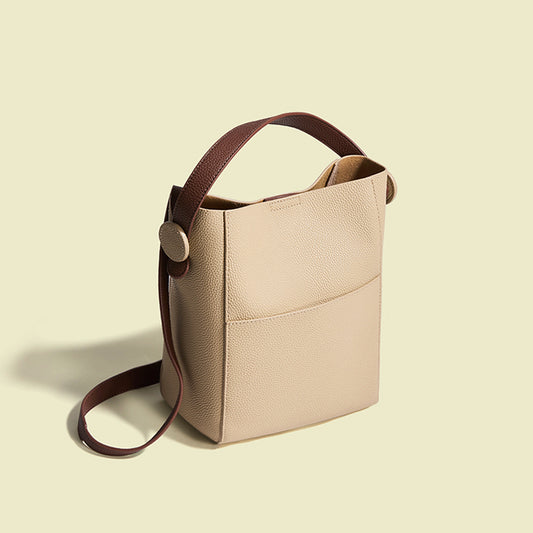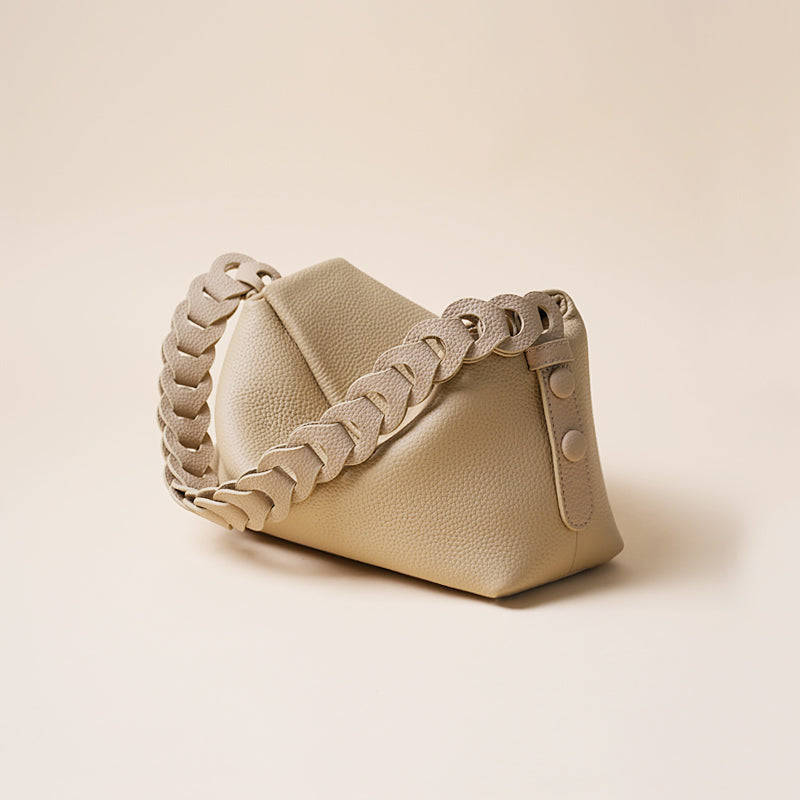Would you want to purchase split leather for leather products or DIY projects? The evaluation highlights the main characteristics of this leather kind, its advantages and disadvantages, maintenance instructions, and recommendations for craftspeople.
A layer of genuine animal skin, generally from cattle, such as cowhide or buffalo skins, is referred to as split leather. In most situations, it is cow split leather obtained from the grinding and splitting of a hide's top layer. When the hide is split, it is separated into layers (up to 3 to 6 layers, depending on the thickness of the hide) with different qualities, which are subsequently utilized for diverse purposes. Thick cowhides are simply split if they are more than 0.2 inches thick.
Splits, as opposed to grain leather, have a lovely velour-like, smooth structure, indicating that a sharp knife from the splitting machine has gone through it. Looking at the unprocessed hide, you can see that the rear is covered with various veins.
If at all feasible, check to see if the split leather is single-layered and not bonded together from two thin plates. The same procedure is used to assess the natural raw material in the case of a belt, which only has to be bent.
Leather Honey is a cleaning solution ideal for anyone who has discolored or badly dirty split leather products. It quickly removes dirt and grime, resulting in a superb repair job.
Where may split leather be used?
Although split is theoretically a sort of natural leather, it is neither very robust nor wear-resistant. Shoes constructed of split leather, for example, will not withstand muddy or wet conditions. Craftsmen frequently use low-cost materials to create inexpensive cow split leather gloves, shoes, and headgear. This material appears to be beautiful and costly. However, avoid working in the rain or snow while wearing split leather clothing and accessories.
Because the upper layer of split leather is more water resistant, it is not advised for making DIY capes, coats, or shoes. The surface structure can only be broken by a sharp cutting using specific tools, no matter how you twist or bend it. It is feasible to soak such a product to increase its durability. Yes, split grain leather outlasts all others in this area.
However, belts made of this material can be virtually as excellent as those made of high grain leather, but at a far lesser cost. Natural split leather, unlike replacements, does not melt or burn; nonetheless, it cannot survive the impacts of rain.
Split leather has the following distinguishing characteristics:
- It features a silky lining and a velvet-like front covering.
- Although split leather is less expensive than suede, the two materials are quite similar.
- Pores on such material are impossible to detect.
- It is monotone in color, with no spots or tints - both natural and dyed;
- This substance has no distinguishing odor.
- You may notice dents on the surfaces if you press your finger on the material and hold it there for a short time.
Split leather comes in several varieties.
Cowhide leather is often divided into three layers: grain (top-grain), middle, and flesh. The center split can only be accomplished if the hide used is thick. The split obtained from the top-grain split is referred to as a drop split by experts. The drop-split layer resembles the back of natural grain leather and has a rough feel on all sides.
Experts recommend simply utilizing the grain split layer since it maintains a lovely smooth surface. The intermediate layer is used to make footwear, furniture upholstery, and household items that require inexpensive leather. Because its properties are inferior to that of grain leather, the raw materials are further treated. Typically, split leather is coated with a polymeric layer before being treated by pressing. As a consequence, whether smooth or embossed, the new covering seems to be top-grain leather that mimics premium real leather.
Split leather has the following advantages:
- It is inexpensive;
- it can withstand the impacts of chemical agents;
- it repels moisture;
- Long-lasting and useful;
- It has a smooth and appealing surface.
- Extremely wear-resistant;
- Simple to process and apply to DIY projects;
- You may rapidly polish it to give it the excellent look that most costly leather varieties have;
- Material that breathes;
Split leather has the following drawbacks:
- Because natural split is less elastic, it responds to straining more negatively.
- It does not recover its shape and is easily distorted;
- Deforms as a result of high temperatures;
- When it is lined with fabric, the split leather does not let much air travel through.
- Rain and snow are not resistant;
Cow split leather is a popular material.
- Genuine suede leather. The most expensive kind of polished leather. It is both uncommon and costly. The tanning procedure is used to create it from the hides of wild animals (deer, moose) and tiny cattle. Suede has a velvety texture to it.
- A type of chrome-tanned leather is velour (also made from swine leather). Velour is sometimes wrongly referred to be sued. However, its front surface is narrower and thoroughly polished from side to side. Velour is suitable for skirts and vests;
- Low-grade suede raw materials. The flesh layer of split leather is used to make work gloves, aprons, and special clothing.
The distinctions between velour and split leather
Velour is produced from tiny cow and pig skins. It can be made from natural leather with various flaws. Because the front surface is not smooth, and the inner side is polished, the result is a dense monochromatic color with a low pile.
In contrast, to split leather, velour leather is tanned using chromium. These leather kinds are distinguished by a good and thick pile surface, which is occasionally lifted with the help of titanium or zirconium salts.
The distinction between PU leather and split leather
The majority of faux leather products of poor quality are made from the lower layers of split leather. Typically, such materials are used to make shoes, gloves, and workwear. When deciding between split leather and PU leather, the former is preferable. If you're asking whether the split leather is vegan, the answer is no. If you need to utilize a vegan material, go with PU leather.
Tips for Purchasing Split Leather Bags
The majority of low-cost suede bags are composed of split leather. Natural suede is rare to locate for sale, and it costs hundreds of times more than the typical price of split leather shoes. Splits-based clothing offers a fantastic appearance but is less stretchy and robust.
If you are planning to buy a traditional model of a purse, such as an office leather bag, it makes sense to invest in a less expensive split purse. Such a leather bag will look fantastic and survive for many years if properly maintained. Split leather boots and other split leather purses will not last!
How to care for leather bags with split leather:
- Only clean the filthy bags when they have dried fully.
- At room temperature, let them air dry. If needed, use a paper towel to pat them dry. Drying near the heater battery may cause material damage.
- A brush is required to remove dust and microscopic droplets of dirt. A coarse-grain rubber is used to wipe out the darkened parts.
- For 2-3 hours, apply talcum powder on oily areas. The powder should then be swept away using a brush. Stains that are dry and tenacious should be removed with gasoline or a specific solution.
- If you plan to take such bags in the morning, use water-repellent shoe spray in the evening. In this manner, the surface will have ample time to absorb it thoroughly.
- To smooth the surface, leather bags must be held over the steam for two to three minutes.
Common split leather care hints
- After wearing, thoroughly dry the split leather items; minimize exposure to sunlight, batteries, and heaters.
- Purchase a specialized rubber brush to frequently remove dust and dried dirt from the product.
- A moist towel can be used to clean the bottoms of split leather shoes.
- Before stepping out, apply a moisture-repellent solution to the surface.
- Make use of a specific sponge and brush;
- Buy aerosol paint to even out the hue and eliminate grime.
- Wipe away the stains with ammonia, soapy water, or gasoline. Breadcrumbs just rubbed the discoloration;
Leather Honey is a cleaning solution ideal for anyone who has discolored or badly dirty split leather products. It quickly removes dirt and grime, resulting in a superb repair job.
It is recommended to use a vacuum cleaner to remove dust from the split leather sofa (with a suction nozzle). The product should then be wiped down with a slightly wet towel. And then roll it using a rubber roller.
The fibers of your shoes or clothing may stay together if you have rain stains on them. A unique rubberized brush will aid in their separation. Simply comb through the top layer, raising it in various directions.
Last thoughts
Split leather is an excellent choice for craftspeople and those searching for a material that is both economical and fashionable. If you want to purchase genuine material at a cheap price, make sure to get original leather items with the mark "split."
















